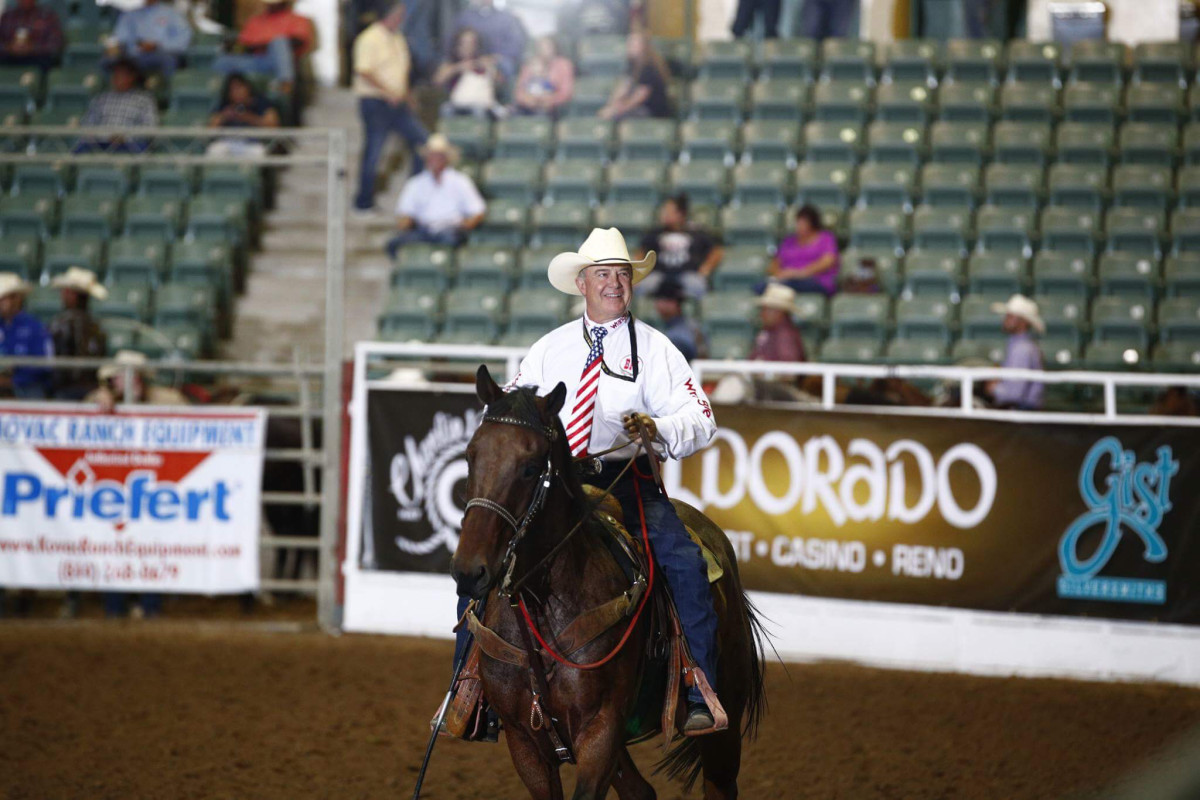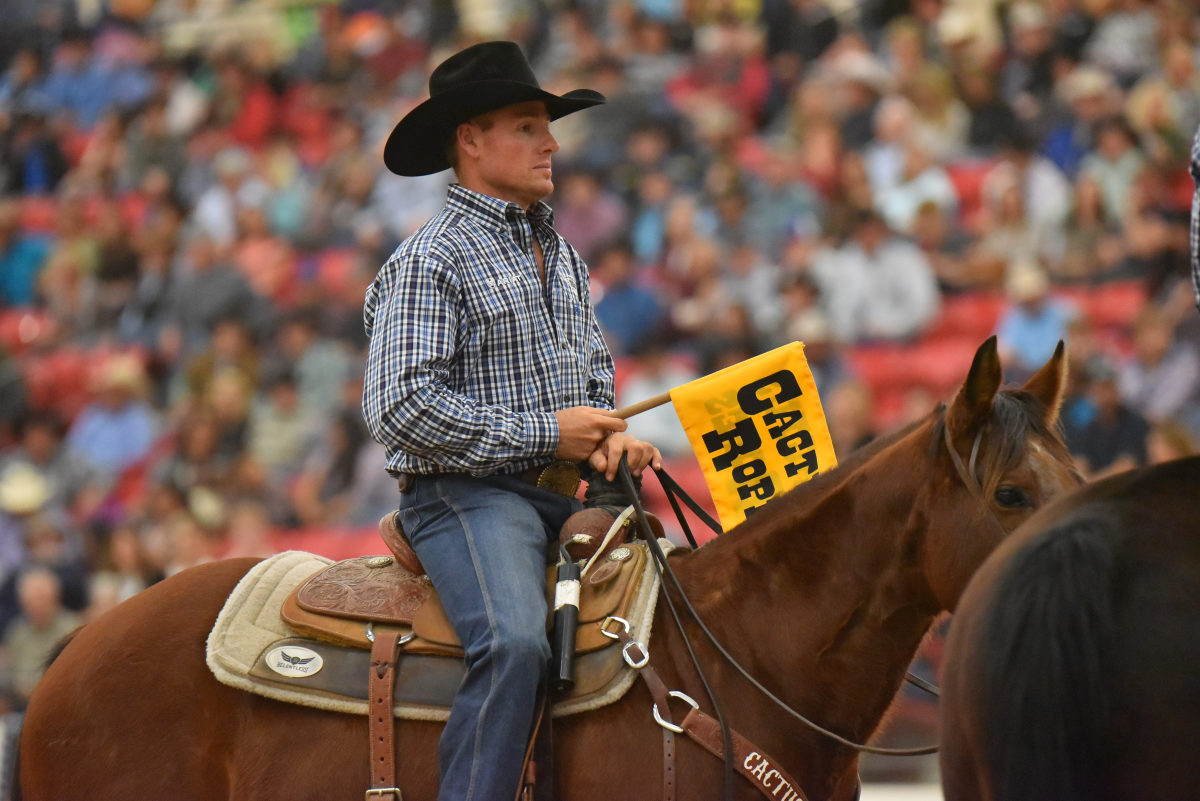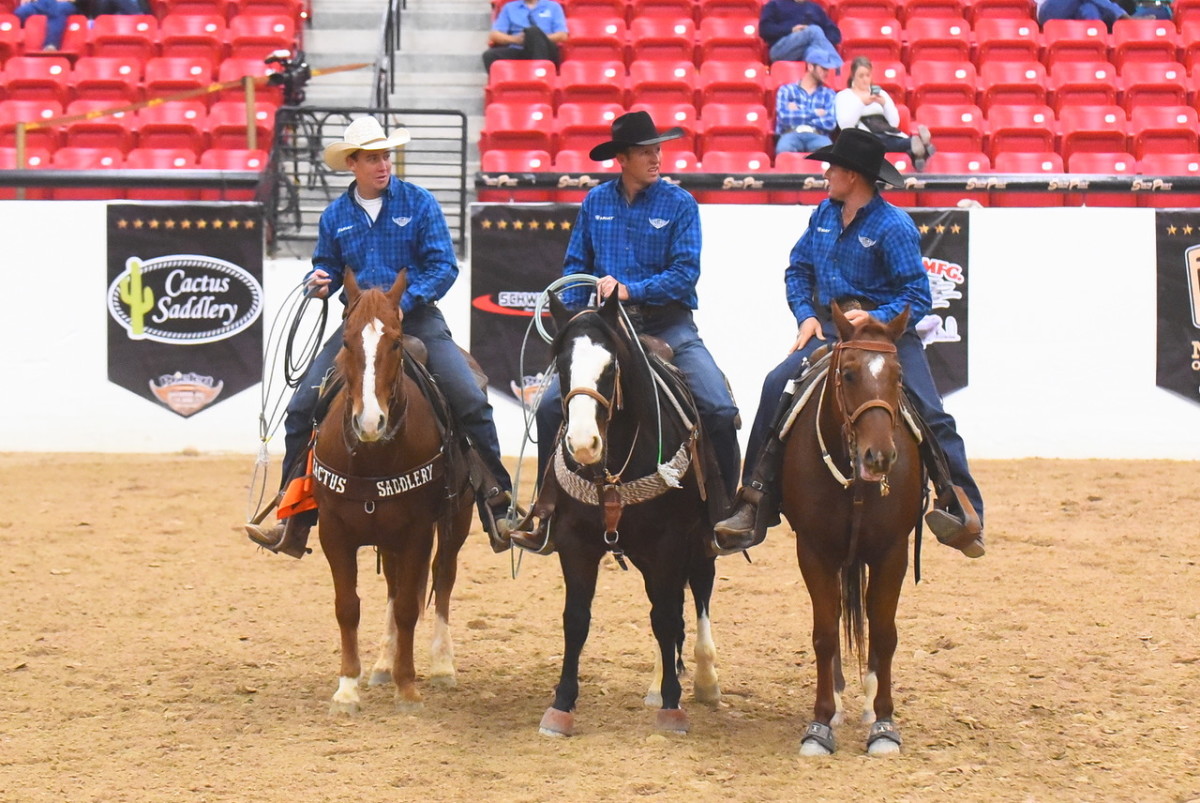As the lucrative purses in team roping today increase, so does pressure on the sport’s referee, or flagger.
Most flaggers get into the profession to subsidize their team-roping habit. But the most revered veteran in the trade hasn’t entered a roping in 18 years. That’s Philip Murrah of Pauls Valley, Oklahoma, a cabinet-maker by trade who’s been flagging full-time for 27 years now—starting with Denny Gentry’s USTRC and now coming full circle, back with Gentry.
In the early 1990s when Murrah was getting started, he gave producers a money-back guarantee if they weren’t satisfied with his performance. Nobody ever took him up on it. And he continues to turn heads not just for the way he drops the flag—so fast it pops—but also for the neckties he wears and the seriousness he brings to the job.
“I’ve probably done just about every major roping except the George Strait and the Windy Ryon,” he said. “I’ve done the BFI for 23 years and the Reno Million for 22 years, and the Ladies Only until this year. I also flag the team roping and barrel racing at RFD-TV’s The American in Dallas and American Semi-Finals in Fort Worth.”

Flagging is easily the most mentally and physically demanding role in team roping. Murrah and three other flaggers who’ve logged time for the USTRC and WSTR are here to give us an idea of the toll of the job—Troy Shelley and his son, Ethan Shelley of Gila, New Mexico; and Brook Bearden of Dublin, Texas.
The job is about more than dropping a flag. It’s about the finesse of hand signals and sign language to notify the announcer/timer what just happened, constantly listening to make sure each run is recorded correctly and constantly watching. Scanning the barrier to see if it’s working; the dirt to see if it needs worked up; the entire pen to ensure it’s clear for the next team.
“You’ve got to be hustling,” said Murrah, who at one time flagged up to 45 ropings a year throughout the country. “You’ve got to be mentally and physically strong if you’re going to do it.”
Flaggers are horseback 10 to 12 and even 15 hours per day and commonly must ride a stranger’s horse, which is tougher than it appears.
“It takes a lot of horse power to flag a big roping,” Murrah said. “[When I was] at Reno over two days, I rode seven or eight horses.”
Less apparent but definitely part of the job description are the emotional demands of calling the action as it happens—especially when re-runs have become part of the jackpot game.
When young Ethan Shelley was just 20 and starting out, he had to deal with his own share of hassling. However, his size helped the intimidation factor—he’s 6’4” and 245 pounds.
Obviously it’s a tough job. So why do these guys do it? Bearden sums it up.
“I’ve met a lot of people along the way who are like family now,” he said. “I get to see them a couple times a month and we meet up and cook out at some of these ropings. There’s a fellowship that comes with it that I really enjoy. And I’ve watched ropers’ kids grow up dummy roping and now they’re 9 heelers. I’d say, also, that it keeps you involved; I’ve sold some horses through the connections. Plus, I get to rope.”

Murrah, too, marvels at the people he’s met, like family, and the country he’s seen. Bottom line, Murrah doesn’t think the sport has enough up-and-coming flaggers that want to do it.
TRJ: How long have you been flagging and how’d you get into it?
Philip Murrah, 55: I’ve flagged since I was in junior high in the late 1970s. We had a little indoor arena and had weekly ropings. Back then, jackpots were open to the world.
Troy Shelley, 54: I started flagging in high school at little jackpots we had at home. I was poor and wanted to rope, so I’d go flag. Then I was going to school in Las Cruces and Junior Campbell would let me flag all day for two or three entries.
Ethan Shelley, 26: I’ve been working ropings for my dad since first grade, so I grew up around it, and started flagging when I got into high school. I kind of had to, because Troy needed a flagger.
Brook Bearden, 42: I’ve flagged USTRC ropings for about 10 years, and got into it because Ken, Kirk and Craig Bray are my cousins on my mother’s side. And then, Troy Shelley was a friend who hired me for WSTR ropings, plus I’ll do some truck and trailer ropings.
TRJ: What does flagger training entail?
T. Shelley: You can train flaggers all you want, but the only way to learn is just to get out there and log the hours. Also, you can either do it or you can’t. Some of my best friends have tried to flag for us and they’re terrible. A flagger has a feel for it, just like anything. I want my flaggers to have a sequence of things they watch, like a machine. You watch the head rope go on, you watch the steer turn, watch the heel rope go on, watch the heeler dally, watch the header face and you flag. It’s not brain surgery, but some people can’t do it, for whatever reason. It’s just like some people head steers better than others and some people shoot a basketball better than others. You either can or you can’t. I’ve seen a lot of Open ropers try to flag and they’re terrible.
E. Shelley: When I did my first World Series in Las Cruces, my dad sat out there with me the entire roping and told me, “This is where you need to ride; stay this far away; this is what you watch for,” etc. The biggest thing he told me is that consistency is key.
TRJ: Any advice for team ropers on engaging with a flagger?
T. Shelley: Slow down before you come back. A lot of ropers think they know what happened in the run, but most of the time they don’t.
Murrah: It’s like a guy at the blackjack table—remember the dealer is not there to be against you. If you win, it’s good for him. If I had my druthers, everybody would win first. But it doesn’t work like that. They don’t pay me any more money depending on who wins first. I like to see people enjoy themselves and have fun. Flaggers are not there to be against you. I haven’t ever seen one flagger I thought was there to cheat somebody.
TRJ: What are the biggest challenges?
E. Shelley: I think crossfire is a kind of a hard rule for most people to get. As a heeler, when your steer is fading left and your header catches, you think the steer is turned. But in all reality, the header might not have him in tow. That’s a really hard call for anybody to make.
Murrah: On the other hand, the flagger could be watching the horse and not paying attention to the steer. So when the steer is completely turned but the horse is still going straight down the pen, a lot of guys get flagged out when they were actually legal. Another mistake a flagger can make is getting too close to the run. If you see a flagger turn his head to the right or left, that’s not good. He needs to stay back far enough to be able to see both ropers dallied in a straight line—in one view.
Bearden: Team roping has gotten to where it pays so much and there’s so much money on the line that everyone wants the perfect chance. So anything outside the “perfect” sphere makes them think the steer was too fast or too slow or checked off or faded left and they need another one. Problem is, we can’t all rope the exact same steer. I understand people don’t want the draw to take them out of the roping. But the other side of that is re-runs for everything.
TRJ: What, in your opinion, are characteristics of really good flaggers?
E. Shelley: Just actually caring about the job they do, like any other profession. It’s hard, because it gets so repetitious. That’s why, if I see something questionable that I think someone might come to talk to me about, I remember the color of the steer, where in the arena it was roped, and probably the color of the horses. It’s tough for us to remember what the guy looked like when we’re not up close.
Murrah: Fairness and consistency. I flag every run the same, every time I flag. Some guys get too wound up, but I don’t care if you’re my son or Trevor Brazile.
The action in the arena is all I focus on, so a run at a jackpot in Pauls Valley and a run in AT&T Stadium for $1 million are both the same to me. The other thing is, when a flagger makes a mistake, he needs to just eat it and go on—not try to make up for it on the next few runs. Finally, the basic fundamental is “don’t flag what you don’t see.” So you have to ride good position, just like a team roper, to set yourself up for the best shot. Most often I’m over on the header side. At the American, I go to the heel side like Harry Rose at the NFR. Otherwise, you’re trapped.
Bearden: A flagger can’t sit out there and daydream; he needs to be extremely watchful. And I think a flagger’s biggest asset is the ability to communicate with the ropers and see a run come together—to see an entire run as its happening. If a head horse is fast, you might expect him to hit that heeler harder, who will then slide a little rope before they get straight.
T. Shelley: Beyond the ability to make good calls, a flagger has to be present and have that arena presence. I’ve known some pretty good flaggers who put off a bad vibe and didn’t really get along with the customers.
TRJ: So how would you define “arena presence?”
T. Shelley: They have to have some command of the arena and look good out there, like they know what they’re doing, and have respect on the ground.
Murrah: I wear a tie at the bigger, better ropings and use a red-white-and-blue flag. You’ve got to bring something to the show. Your horses need to look good and you should be starched up, sit up straight and look good, especially at events with a big opening ceremony. Also, I never smile in the arena. I figure they’re not paying me to smile, they’re paying me to take care of business. I hold the reins pretty tight.

Know the Rules:
While most rules are fairly straight forward, there are some calls on which the judgement of the flagger is absolutely critical. The one that is most subjective at ropings and rodeos has to do with the ability to compete in determining reruns. Here is the World Series of Team Roping’s interpretation of that rule:
ABILITY TO COMPETE –is the only criteria used to determine reruns. In addition there are two different perspectives on ability to compete. Flaggers are instructed to give the benefit of the doubt to ropers in any 50-50 “ability to compete” decision within the first three go-rounds of any event. However, the decision criteria will be different within the short-round. Short rounds will be held to a much stricter judgment. This is not a 50-50 situation, and there must be ABSOLUTELY NO-DOUBT to the Flagger, that a team did NOT have a fair ability to compete, before a rerun will be awarded.
Ability to compete does not come into play when it appears to the Flagger that a contestant, or a rope horse, or lack of riding skill causes the problem (head horse doesn’t rate and sets up the steer, heeler turns in at the head and causes the steer to drag, etc) “Ability to compete” decisions are NOT situations where a steer merely slows down as the ropers approach, steers that run to the left fence, steers that are heavy and step out of the corner instead of hopping, trot instead of hop, and a host of other reasons that some ropers feel should afford them a rerun. “Ability to compete” decision might involve an excessively fast steer, or excessively slow steer. Otherwise, drawing between the bottom and top of the herd is still a variable of the sport.










